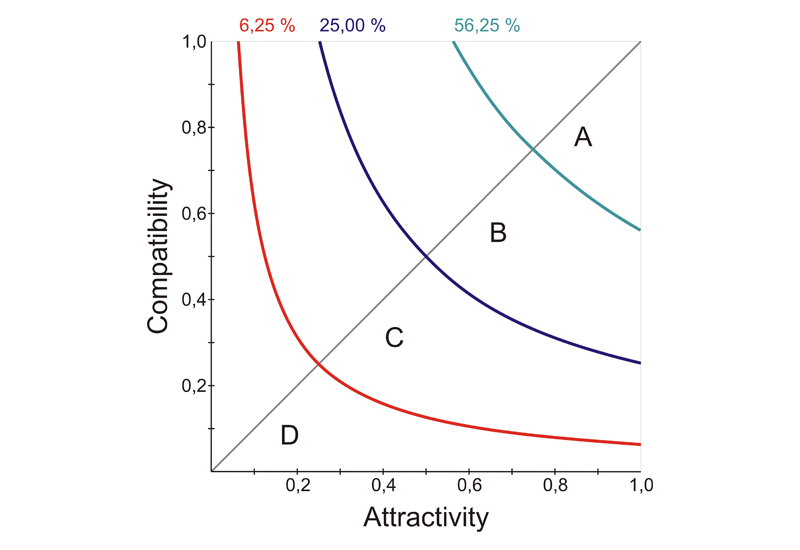By: Dr. Reinhard Fricke
Clear separation of top ideas from mediocre and weak ideas is essential, before financial and other resources are allocated. The Hyperselect method provides a new, sound and improved way to fulfill this task. Moreover it reveals, that hyperbolas might be “the better matrix” in quite a lot of methods for prioritization and beyond.
Anything wrong with the matrix ?
Evaluating and selecting the best ideas is a crucial step on the way from the fuzzy front end of an innovation process to its focused back end. Therefore, companies need appropriate criteria and trustworthy, efficient methods. Widely used are 2×2 and 3×3 matrix displays which however have some substantial shortcomings. These are overcome by the Hyperselect method, an advanced approach to evaluating and selecting ideas and more.
Experience shows, that good concepts developed for a specific task are later on often used for tasks exceeding the limitations of their original framework.
Experience shows, that good concepts developed for a specific task are later on often used for tasks exceeding the limitations of their original framework. This is being done without bringing into question whether their fundamental prerequisites are still fulfilled.
When the BCG portfolio analysis became popular, the matrix display was used more and more for other tools of management, amongst them being methods to prioritize ideas. The BCG portfolio matrix was and still is sound from a logical point of view: its grid and parameters is only used in the way a map is used to define locations with its East-West and North-South directions.
Attractivity AND compatibility – hyperbolas show the logical way
However, things are different, if the matrix grid is used for a concept which targets at a “as well as – combination”. If there are for instance two sub concepts like “the attractivity of an idea per se” and “the compatibility of an idea with the abilities and strategy of a certain company” and the target is to identify those ideas that are attractive in themselves as well as compatible with the company, the objective term (i.e. the overall value of an idea) is mathematically expressed by the product of the attractivity-value and the compatibility value.
This is due to the basic principles of Boolean logic which says that the “as well as – combination” means a logical AND (conjunction), implying multiplication.
overall idea value = attractivity * compatibility
V = A * C
In order to compare and select ideas in a graphical display with attractivity on the horizontal axis and compatibility on the vertical axis of a diagram, lines indicating equal overall idea values are needed.
const. = A * C
i.e. C = const. / A
This provides a set of hyperbolas instead of a rectangular matrix grid and motivates the origin of the name Hyperselect. Typically the values for attractivity and compatibility are derived from respective sub sets of criteria in a precedent step.
Hyperselect: focus on what’s really worth it
The basic display of the Hyperselect diagram includes three hyperbolas representing overall idea values of 6,25% , 25% and 56,25% of the maximum. These figures are deduced from dividing the diagonal into 4 equal parts, which provides good orientation without cluttering and convenient comparison with the 2×2 matrix grid. The resulting areas A, B, C and D represent 4 categories, which are additionally divided in halves by the diagonal.
As a result precious financial and human resources are only allocated to really valuable ideas and follow-up projects.
The Hyperselect approach does not only overcome the logical shortcomings as described above. Furthermore, it provides clearer separation of bad, mediocre and excellent ideas and helps to detect potentials for idea improvements. It is particularly remarkable, that the area A, which contains the best ideas, only covers a little more than 11% of the total area and provides only 56,25% of the highest possible overall idea value as the lower limit. Ideas, which might look pretty good in matrix based evaluation methods, will turn out as mediocre under the demanding Hyperselect criteria.
In this way the Hyperselect analysis helps to set a high standard. An in-depth analysis indicates advantages of up to 30 % in terms of reliability and separation quality for data obtained from a Hyperselect based idea prioritization compared to matrix based methods. As a result precious financial and human resources are only allocated to really valuable ideas and follow-up projects.
Extended applications
Modified and extended versions of the Hyperselect method can be adapted to other fields of application like project prioritization in multi project management and strategic planning within the framework of innovation management. It can be used by single persons but excels when used in management teams.
Conclusion
Hyperselect was first introduced as an advanced method for idea prioritization but it is in no way limited to that. It has already been extended to other management areas. Compared to matrix based methods it delivers more accurate and sound results, whenever the target item is made up of an “as well as” combination i.e. an AND conjunction of two quantities. In all of these cases the hyperbolas provide “the better matrix”.
By Dr. Reinhard Fricke
About the author
 Dr. Reinhard Fricke is professor for innovation management at Leibniz University Hanover in Germany and management consultant for innovative midsize caps and renowned large companies. He developed the Hyperselect method. Other methodological contributions are on advanced innovation processes und multidisciplinary teams.
Dr. Reinhard Fricke is professor for innovation management at Leibniz University Hanover in Germany and management consultant for innovative midsize caps and renowned large companies. He developed the Hyperselect method. Other methodological contributions are on advanced innovation processes und multidisciplinary teams.
Photo : Abstract night by Shutterstock.com


